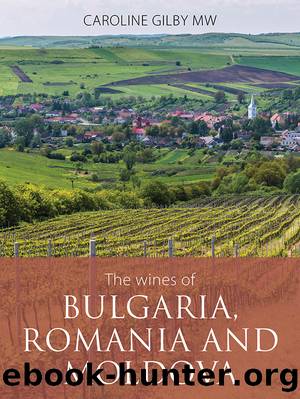The Wines of Bulgaria, Romania and Moldova by Gilby Caroline;

Author:Gilby, Caroline;
Language: eng
Format: epub
Publisher: Infinite Ideas
Published: 2018-06-25T16:00:00+00:00
Riesling
This is the name used in Romania for Graševina (a.k.a. Welschriesling, Italian Riesling or Riesling Italico). There were 7,520 hectares in 2017. There was very little true (Rhein or German) Riesling at one time, though by 2017, there were 330 hectares of genuine Riesling (usually labelled Riesling de Rhin for domestic sales).
Producers worth trying: Vinarte (Riesling), Carastelec (Rhein Riesling), Lechburg (Rhein Riesling), Villa Vinèa.
Sauvignon Blanc
There were 5,614 hectares in 2017, reflecting the domestic popularity of this grape, often vinified with some residual sugar and without the aromatic intensity of a New Zealand or Loire style. Several producers now make acceptable commercial dry styles.
Producers worth trying: Avincis, Budureasca, Corcova, Davino, Jidvei, La Salina, Viile Metamorfosis, Villa Vinèa, Vinarte.
Syrah
This is another international grape that needs no introduction. It was first planted in Romania by Carl Reh in around 2001, when it was not a registered grape variety for the country. They initially produced it as a very limited selection of 2 to 3 barrels in a magnum bottle sold on allocation only. It has since become a permitted grape variety, planted on 503 hectares according to 2017 data. Several other producers are also now making successful examples as it seems to suit some of the country’s warmer locations.
Producers worth trying: Catleya, Corcova, Crama Oprișor, Nachbil, Viile Metamorfosis.
OTHER INTERNATIONAL VARIETIES
These include Neuburger (in Transylvania due to its popularity in German communities and its ability to accumulate sugar in low sunlight), Furmint (in Miniș, notably Balla Géza), Viognier, Kerner, Zweigelt, Roșioară (2,661 hectares, Bulgaria’s Pamid), Rkatsiteli, Portugieser, Sangiovese, Kadarka (known in Bulgaria as Gamza and usually spelt Cadarcă here), Cabernet Franc, Malbec, Gewürztraminer, Marselan, Muscat Ottonel (4,898 hectares due to popularity in the domestic market), Petit Verdot and Dornfelder. (See Appendix II for the full list.)
THE BLEND STORY
In Romania, as in Bulgaria, blends have become important and often feature as flagship wines, usually made in small quantities. SERVE’s Cuvée Charlotte was the first super-premium Romanian red, released by the influential Corsican Count Guy de Poix in 2000. It was a wine that put Romania’s potential on the wine map and inspired many others. Today Cuvée Charlotte, with its blend of Bordeaux varieties and Fetească Neagră continues to be a standard bearer, though it is no longer alone. White blends are less common but there have been notable successes in a small number of cases.
Red blends worth trying (in alphabetical order by producer): Aurelia Vișinescu Red Artizan, Avincis Cuvée Grandiflora, Balla Géza Stone Wine Fetească Neagră/Cabernet Franc, Budureasca Noble 5, Catleya Epopée, Crama Oprișor Ispita, Crama Oprișor Smerenie, Cramele Recaș Cuvée Uberland, Davino Reserva, Davino Flamboyant, Domeniul Coroanei Segarcea Simfonia, LacertA Cuvée IX, Petro Vaselo Ovas, SERVE Cuvée Charlotte.
White blends worth trying (in alphabetical order by producer): Cramele Recaș Solo Quinta, Davino Reserva, Davino Revelatio, Domeniile Tohani Siel, SERVE Cuvée Amaury.
THE HYBRID ISSUE
One subject that most Romanian growers don’t want to talk about is that of the significant plantings of hybrid vines (also known as direct producers) that remain. These are crosses between non-European (usually
Download
This site does not store any files on its server. We only index and link to content provided by other sites. Please contact the content providers to delete copyright contents if any and email us, we'll remove relevant links or contents immediately.
| Buying Guides | Cellars |
| Champagne | Collecting |
| Spirits | Whiskey |
| Wine | Wine Pairing |
| Wine Tasting |
Whiskies (Collins Gem) by dominic roskrow(42210)
101 Whiskies to Try Before You Die by Ian Buxton(42177)
Whiskies Galore by Ian Buxton(40329)
Craft Beer for the Homebrewer by Michael Agnew(17445)
Right Here, Right Now by Georgia Beers(3497)
Not a Diet Book by James Smith(2725)
Water by Ian Miller(2582)
The Coffee Dictionary by Maxwell Colonna-Dashwood(2531)
Kitchen confidential by Anthony Bourdain(2306)
Coffee for One by KJ Fallon(2007)
Smuggler's Cove: Exotic Cocktails, Rum, and the Cult of Tiki by Martin Cate & Rebecca Cate(1979)
Beer is proof God loves us by Charles W. Bamforth(1920)
Superfood Smoothie Bowls: Delicious, Satisfying, Protein-Packed Blends that Boost Energy and Burn Fat by Chace Daniella(1901)
Talking as Fast as I Can by Lauren Graham(1832)
Bourbon: A Savor the South Cookbook by Kathleen Purvis(1791)
A Short History of Drunkenness by Forsyth Mark(1718)
Eat With Intention by Cassandra Bodzak(1687)
Cocktails for the Holidays by Editors of Imbibe magazine(1626)
Colombia Travel Guide by Lonely Planet(1609)
